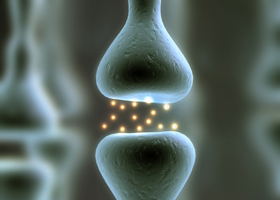Feature Story
Health Center Today, July 13, 2010
Understanding Balance in the Nervous System
By Christine Buckley

A synapse.
The human brain contains more than 100 billion nerve cells, or neurons, which send electrochemical signals throughout our bodies to create thoughts, movements, and sensations. But, says UConn researcher Angel De Blas, our nervous system couldnít function properly if not for a delicate balance of excitement and inhibition between individual nerve cells.
"Itís like driving a car," says De Blas, a professor of physiology and neurobiology in the College of Liberal Arts and Sciences. "You have to have a pedal for the gas and a pedal for the brake. In the same way, nerve cells can have excitatory or inhibitory effects." If these two types of nerve impulses donít balance each other, he says, it can cause neurological syndromes, such as epileptic seizures.
De Blas and his graduate students are investigating an inhibitory signaling pathway in the brain that is the target of many so-called anxiolytic medications, including anti-anxiety and anti-epileptic drugs, sleep aids, sedatives, and anesthetics. Theyíre funded by a four-year grant from the National Institutes of Healthís Institute of Neurological Disorders to try to understand how these impulses are transmitted, which will help researchers determine how these types of drugs act in the body.
Neural signaling in the body occurs within the synapse, the space between two nerve cells where chemicals are sent from one cell to the next. Named for the molecule it uses to transmit signals, called gamma-aminobutyric acid (GABA), the type of synapse De Blas studies reduces the strength of electrical responses by nerve cells, tempering the effect of excitatory impulses.
Despite their importance in maintaining neurological balance, De Blas says scientists still donít know some basic things about how GABA synapses are constructed.
"We donít really know how these synapses are put together," he says. "We want to understand the basic biology of GABA transmission and the molecular organization of these inhibitory synapses."
Nerve cells communicate with each other by releasing chemical molecules into the synapse. These neurotransmitters Ė like GABA Ė are released by nerve cells and received by special receptors on the cell membrane of neighboring cells. The receptors then convey specific instructions to the receiving cell, telling it what kind of signal to pass along to the next cell.

Angel De Blas, professor of physiology and neurobiology, in his lab.
Photo by Peter Morenus
Found in the brain and spinal cord, these GABA-releasing nerve cells are often involved in producing relaxation in the body. These effects can be enhanced by medications, such as Valium, that enter the synapse and also bind to the GABA receptor, increasing the GABA inhibitory signal.
De Blas is currently identifying and studying the proteins that make up the GABA synapse, including those that hold the synapse together and those that anchor the GABA receptors at synapses. By comparing the molecular organization of normal synapses with those whose suite of proteins has been altered, De Blas is beginning to understand the role of these proteins in certain neurological disorders and the effect of some drugs on human neurons.
Many successful drugs work as well as they do, De Blas notes, because they mimic a substance already produced by the body to serve some physiological function. Often the discovery of these endogenous substances occurs after scientists understand the effects of a drug on synaptic functions.
An example is the discovery of endocannabinoids, molecules produced by the body which modulate appetite, mood, and memory, and have a physiological effect similar to some active ingredients in marijuana. Opiate drugs can also overwhelm the natural effect of naturally-occurring endorphins, which are made by the brain. De Blas and his colleagues are using several different technologies to discover whether the brain creates molecules that are similar to these GABA-enhancing drugs. Manipulating these endogenous molecules could help to treat anxiety, sleep disorders, and epilepsy.
De Blas says that to him, research is an exciting challenge because of its variety. He spends each day trying to design new research strategies and make sense of experimental results. He attributes much of his progress to the development of new technologies.
"As our technology improves, it allows us to probe the brain scientifically to discover new and exciting things in our brain," he says. "The field of neurobiology evolves, our knowledge increases, and better therapies are developed, but many of the important questions are still the same. How does the brain work? How do we learn and remember? How do we think and feel? Weíre making big progress but we still donít know many of the answers."


